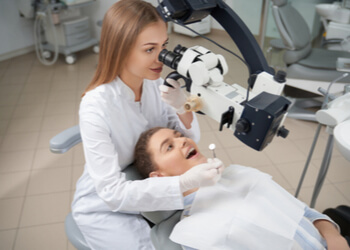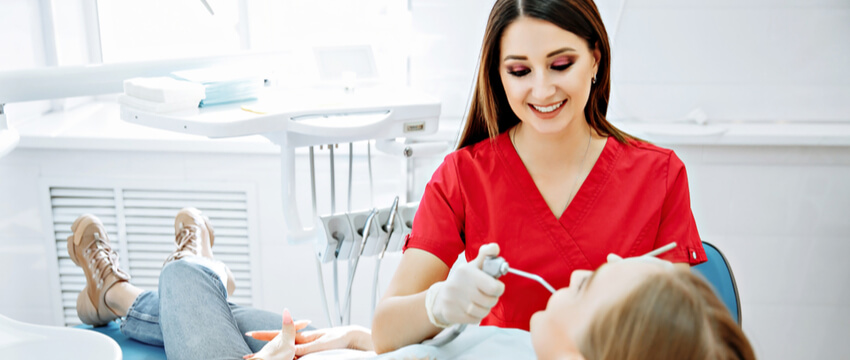What is an autoclave?
A medical autoclave uses pressurised steam to sterilise medical and dental equipment. This is an extraordinarily efficient way to sterilise dental equipment, as three minutes of steam exposure at 134 degrees Celsius provides a level of sterility equal to two hours of exposure to dry air at 160 degrees Celsius.
There are three primary stages to the autoclave’s cycle: the conditioning phase (where air is removed from the pressure chamber), exposure phase (where steam is continuously pumped into the chamber), and exhaust phase (when the steam is drained, and the sterilised items dry off).
This sterilisation process kills a number of harmful contaminants, including spores, bacteria, fungi, and viruses. The steam’s moisture translates the heat efficiently to the items in the autoclave, which in turn breaks down the protein structure of any virus, bacteria, or fungus.
What are some uses of autoclaves for dentists?
In the typical dental practice, autoclaves primarily sterilise small packets of tools or handpieces. However, in larger dental practices that perform dental surgery, a bigger autoclave with more space will most likely be used.
Given a standard dental practice, uses of autoclaves will most likely include the following:
- Sterilisation of dental handpieces
- Sterilisation of packets of tools
- Sterilisation of surgical tools
Remember, it’s crucial to make sure a tool or item is autoclaveable before you put it inside of an autoclave. Here are materials that are autoclaveable:
- Polypropylene
- Glassware
- Stainless steel
- Surgical instruments
- Gloves
- Media solutions
On the other hand, here are some materials that are not autoclaveable:
- Non-stainless steel
- Sulphates
- Polyurethane
- Polystyrene
- Chorine or bleach
- Paraffin-embedded tissue
- Low density and high density polyethylene
- Chlorides
- Liquid in a sealed container
- Corrosive, reactive, flammable or toxic materials
- Any material that touches the interior surfaces of the autoclave
Autoclave sizes and uses
Let’s look at examples of Melag autoclaves from Melag Autoclave. Melag autoclaves are not only incredibly reliable, but they also come in different sizes.
These autoclaves are intelligent systems designed to optimise resource use, reduce waste, and sterilise your dental tools quickly and efficiently.

Melag Vacuklav 31B Pro-class Steam Steriliser
- This Melag autoclave model has an 18-litre capacity, 5 kg interior chamber weight limit, as well as five trays in its sterilisation chamber, making it easy to fit many tools.
- This Vacuklav 31B boasts a chamber depth of 35 cm and a width of 25 cm.
- It features a highly sophisticated noise suppression system, making it extremely quiet. That way, you won’t disrupt conversations with clients when running your autoclave.
- It’s gentle enough to sterilise delicate tools and hollow instruments.
- With a simple and easy-to-use control panel, this autoclave makes choosing between any of its two test programs or five sterilisation programs intuitive and straightforward.
- This autoclave’s compact design, quick-release disposal of used water, and reliability make it an excellent choice.
Melag Vacuklav 41B High-Performance Steam Steriliser
- This is a larger model with a depth of 35 cm, eight interior trays, an interior volume of 18 litres, and maximum instrument weight limit of 9 kg or 2 kg of textiles. This makes it ideal for sterilising longer instruments and tools.
- This Vacuklav 41B can sterilise wrapped or unwrapped implements.
- It also features time-saving, twin-chamber technology.
- Its DRYtelligence software allows the Vacuklav autoclave to intelligently adapt to different load sizes, which means it uses minimal resources and operates each load in the shortest amount of time possible without diminishing performance or effectiveness.
- This renders it highly adaptable to different workloads, making it ideal for a larger practice that experiences different schedules and different autoclave demands.
- Its intuitive, colorful control panels and integrated software enables this autoclave to easily label, track, and approve all of your sterilised instruments, making it simple to keep records for expiry dates and proper operatory procedures.
- Lastly, this Vacuklav 41B can operate as a standalone unit, meaning it does not need a permanent water connection. With its integrated feed- and waste-water containers, it lets you run your autoclave anywhere you can plug it into the wall.
Both of these Melag autoclaves feature powerful vacuum pumps, incredibly efficient air-cooling systems, and integrated water storage. The Vacuklav 31B is an excellent option for a smaller practice, whereas the Vacuklav 41B makes an excellent choice for practices that are larger but still experience some variability in workload and client scheduling.
Conclusion
Melag autoclaves can perform several sterilisation roles in a dentist’s practice, and with the choice of sizes, there is almost certainly a perfect autoclave for your business. At Melag Autoclave, our customer service representatives are ready to answer your questions and walk you through the decision-making process. Contact Melag Autoclave today via our free online contact form or call on (02) 8880 7813 for help answering any of your autoclave questions.


